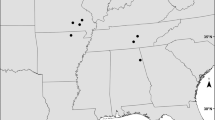Abstract
The biology, ecology, and distribution ofSelenicereus (Strophocactus)wittii, one of the least known taxa ofCactaceae, are described. This epiphyte climbs appressed to tree trunks with leaf-like, flattened stems and is found exclusively along the high waterline of black water rivers (Rio Negro, Vaupés, Apaporis) in the Igapó inundation forests of Amazonia. Ecophysiologically,S. wittii is a crassulacean acid metabolism (CAM) plant. It bears white, nocturnal flowers 25 cm in length which emit a fragrance consisting mainly of benzylalcohol, benzyl benzoate, and benzyl salicylate. They exhibit an extreme sphingophilous syndrome as an adaptation to pollination by probably only two species of hawkmoth from the generaAmphimoena andCocytius. The seeds, aberrant for the family, contain air-filled chambers and are water-dispersed. Thus,S. wittii represents the paradoxical life form of an hydrochorous epiphytic cactus which withstands periodical inundation.
Similar content being viewed by others
References
Barthlott, W., Hunt, D. R., 1993:Cactaceae. — InKubitzki, K., (Ed.): The families and genera of flowering plants,2, pp. 161–197. — Berlin, Heidelberg, New York: Springer.
—, 1975–1976: Some notes on the morphology, palynology, and geographical variability ofEpiphyllum phyllanthus (L.)Haw. (Cactaceae), the type species of the genus. — Natl. Cact. Succ. J.29: 113–115;30: 8–10.
—, 1996: Ecology and morphology ofBlossfeldia liliputana (Cactaceae): a poikilohydric and almost astomate succulent. — Bot. Acta109: 161–166.
—, 1979: Mikromorphologie der Samenschalen und Taxonomie derCactaceae: Ein raster-elektronenmikroskopischer Überblick. — Pl. Syst. Evol.132: 205–229.
Britton, N. L., Rose, J. N., 1913: Studies inCactaceae. — Contr. U. S. Natl. Herb.16: 255–262.
—, 1920: TheCactaceae. — Carnegie Inst. Wash. Publ.248/2: 211–222.
Burr, B., Barthlott, W., 1993: Untersuchungen zur Ultraviolettreflexion von Angiospermenblüten II. — Trop. Subtrop. Pflanzenwelt87.
D'Abrera, B., 1986:Sphingidae mundi. Hawk moths of the world. — London: Classey.
Darwin, C., 1862: On the various contrivances by which British and foreign orchids are fertilized by insects. — London: Murray.
Donath, J., Boland, W., 1995: Biosynthesis of acyclic homoterpenes: enzyme selectivity and absolute configuration of the nerolidol precursor. — Phytochemistry39: 785–790.
Farquhar, G. D., Sharkey, T. D., 1982: Stomatal conductance and photosynthesis. — Annual Rev. Pl. Physiol.33: 317–345.
Gibson, A. C., Nobel, P. S., 1986: The cactus primer. — Cambridge: Harvard University Press.
Grams, T. T. E., Beck, F., Lüttge, U., 1996: Generation of rhythmic and arrhythmic behaviour of Crassulacean acid metabolism inKalanchoe daigremontiana under continuous light by varying the irradiance or temperature: Measurements in vivo and model simulations. — Planta198: 110–117.
Haber, W. A., Frankie, G. W., 1989: A tropical hawkmoth community. — Biotropica21: 155–172.
Kaiser, R., 1991: Trapping, investigation and reonstitution of flower scents. — InMüller, P. M., Lamparsky, D., (Eds): Perfumes, art, science, technology. — Elsevier Applied Science1991, pp. 213–250. — Amsterdam, Oxford, New York: Elsevier.
—, 1993: The scent of orchids. — Amsterdam, Oxford, New York: Elsevier.
Kluge, M., Ting, I. P., 1978: Crassulacean acid metabolism. Analysis of an ecological adaptation. — Ecol. Stud. Analysis Synth.30. — Berlin, Heidelberg, New York: Springer.
Kubitzki, K., 1989: The ecological differentiation of Amazonian inundation forest. — Pl. Syst. Evol.162: 285–304.
—, 1994: Seed dispersal in flood plain forests of Amazonia. — Biotropica26: 30–43.
Leuenberger, B., 1975: Die Pollenmorphologie derCactaceae und ihre Bedeutung für die Systematik. — Diss. Bot.31. — Vaduz: Cramer.
Lüttge, M., Stimmel, K.-H., Smith, J. A. C., Griffith, H., 1986: Comparative ecophysiology of CAM and C3 bromeliads. II. Field measurements of gas exchange of CAM bromeliads in the humid tropics. — Pl. Cell Environm.9: 377–388.
Mee, M., 1988: In search of flowers of the Amazon Forests. — Woodbridge: Nonesuch Expeditions Publisher.
Nilsson, L. A., Jonsson, L., Rason, L., Randrianjohanny, E., 1985: Monophily and pollination mechanisms inAngraecum arachnites Schltr. (Orchidaceae) in a guild of long-tongued hawk moths (Sphingidae) in Madagascar. — Biol. J. Linn. Soc.26: 1–19.
Osmond, C. B., 1982: Carbon cycling and stability of the photosynthetic apparatus in CAM. — InTing, I. P., Gibbs, M., (Eds): Crassulacean acid metabolism, pp. 112–127. — Rockville: American Society of Plant Physiologists.
Peukert, D. E., 1980: Zur Anatomie vonEpiphyllum chrysocardium Alexander (Cactaceae): Epidermis und Stomatogenese. — Flora169: 1–8.
Rundel, P. W., Ehleringer, K. A., Nagy, K. A., 1989: Stable isotopes in ecological research. — Ecol. Stud. Analysis Synth.68. — Berlin, Heidelberg, New York: Springer.
Schumann, K., 1900:Cereus wittii K. Sch. — Monatsschr. Kakteenk.10: 153–158.
—, 1902: Die Blüte vonCereus wittii. — Monatsschr. Kakteenk.12: 137–138.
Seitz, A., 1940: Die Groß-Schmetterlinge der Erde.6. — Stuttgart: Kerner.
Winter, K., Smith, J. A. C., 1996: Crassulacean acid metabolism. — Ecol. Stud. Analysis Synth.114. — Berlin, Heidelberg, New York: Springer.
Ziegler, H., Osmond, B., Stichler, P., Trimborn, P., 1976: Hydrogen isotope discrimination in higher plants: correlation with photosynthetic pathway and environment. — Planta128: 85–92.
Author information
Authors and Affiliations
Additional information
Dedicated to emer. Univ.-Prof. DrFriedrich Ehrendorfer on the occasion of his 70th birthday
Rights and permissions
About this article
Cite this article
Barthlott, W., Porembski, S., Kluge, M. et al. Selenicereus wittii (Cactaceae): An epiphyte adapted to Amazonian Igapó inundation forests. Pl Syst Evol 206, 175–185 (1997). https://doi.org/10.1007/BF00987947
Received:
Revised:
Accepted:
Issue Date:
DOI: https://doi.org/10.1007/BF00987947




